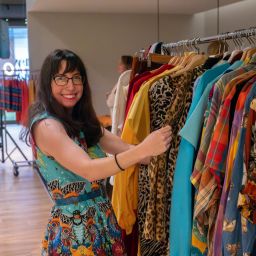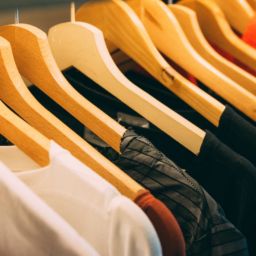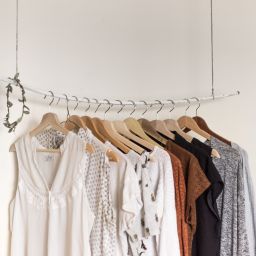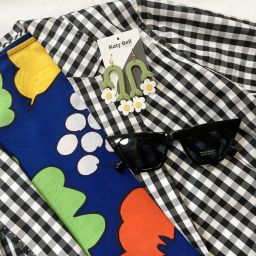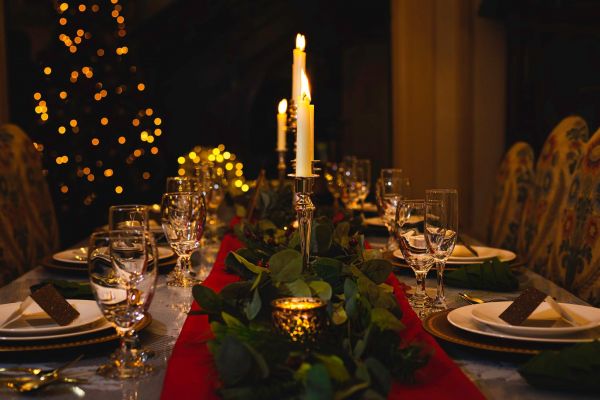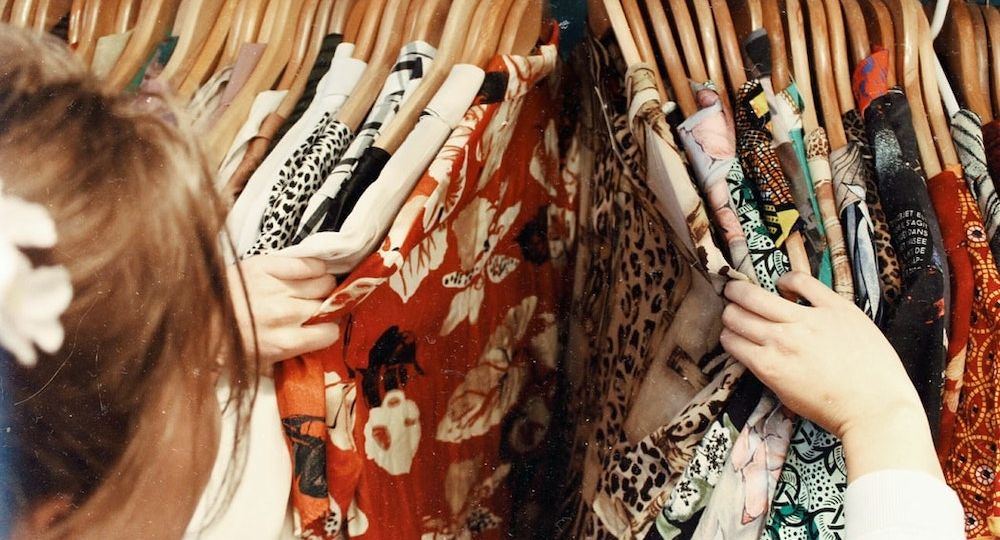
With the rise of “fast fashion,” clothing that’s made quickly and cheaply to meet the passing trends, also came some very real and disturbing consequences, like environmental damage and abuse of garment workers. Sustainable fashion has risen to the forefront of fashion discussion as a result, and for many consumers, buying vintage or secondhand items is a part of the solution.
These four stylish Indianapolis-area women are avid thrifters, and they’re sharing their tips on how to add more vintage and sustainable fashion to your wardrobe. Whether you choose a show-stopping vintage caftan or opt for a garment that’s made of a sustainable material like cotton, hemp or linen, you’re bound to make an impact.
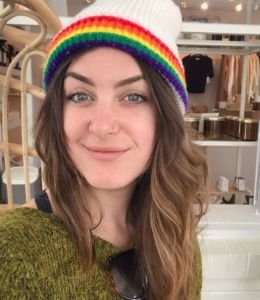
TORI SANDLER, OWNER OF NOTORIOUS VINTAGE AND CO-OWNER OF REBEL VINTAGE
SHOPREBELVINTAGE.COM, @REBELVINTAGEINDY, @SHOPNOTORIOUSVINTAGE
What is your approach to sustainable fashion?
I primarily wear secondhand and make sure I’m seeking out fabrics that’ll hold up longer. When I’m thrifting I don’t let a stain or tear discourage me from buying a piece. Something can be cropped or dyed or altered in some way that it won’t be noticeable and better yet, now you’ve made it your own unique piece! Not only is shopping secondhand a total gold mine of fashion opportunity, the thrill of the hunt is super addictive.
How and why did you get started thrifting/upcycling?
When I was younger, my mom was a vintage dealer so we went thrifting/picking regularly and naturally I picked up the interest after seeing all the fun unique discarded gems out there waiting to be discovered. As far as clothing, as a teen, I had trouble finding the styles I was looking for at the mall or in the department stores, so thrifting was a way for me to have a variety of clothing to choose from that wasn’t just the trendy styles represented elsewhere. As I got older and began to seek out vintage, it was a way for me to express myself through unique, one-of-a-kind styles. To bring life back into beautiful pieces that were no longer being loved like they deserved. Most pieces just need a good soak and they are good as new!
Can you share a couple of tips for others who want to thrift/resale/upcycle?
If you are looking to start thrifting more of your wardrobe, my best advice is to head to the thrift store/secondhand stores and look for the colors and patterns you want and then make the clothing work for you.
I love finding new ways to wear previously loved things. Whether that’s tying up an oversized men’s shirt, or cropping an old plaid, to simply belting an ill-fitted dress. Make the clothing piece work for you and your body. Next you should begin to pay attention to fabrics. Stick with organic cottons, silk, linen … natural fabrics that are better for the environment and will hold up longer versus man-made fabrics that take much longer to biodegrade. Lastly, when you are finished with it, pass it on to a friend or donate it!

ERICA SCOTT, “THE FLY WON”
@THEFLYWON
What is your approach to sustainable fashion?
My approach to sustainable fashion is thrifting for “Won of a Kind Finds.” I have an eye for unique vintage secondhand items. I love to source at thrift stores. Not only is this good for the environment, it also makes for a unique and curated home and wardrobe.
How and why did you get started thrifting/upcycling?
My family shopped at thrift stores growing up and I became very passionate about it in high school. Finding unique, one of a kind items is primary to even the usually discounted price. I like to stand out and not blend in—and thrifting is my outlet to do just that.
Can you please share a couple of tips for others who want to thrift/resale/upcycle?
One tip I have for other thrifters is to train your eye to recognize quality in an item. Know how to spot detail and quality; natural fabrics like silks, cashmere, wool, embroidery, and threading. In decor, look for items that have a nice weight to them and are made of quality materials. Wood, glass, acrylic, ceramic rather than veneer and plastic. These pieces will hold up after time and have withstood the test of time. It makes thrifting far more efficient when your eye can spot a quality item from a distance.

JULIA SPANGLER, CO-FOUNDER OF SECONDARIE
SHOPSECONDARIE.COM, @SHOPSECONDARIE
What is your approach to sustainable fashion with your new company?
Our goal with Secondarie is to make second-hand shopping faster and easier, so people can choose “secondhand first” more often. To accomplish this, we created a search platform that shows results from multiple online thrift stores with a single click. So instead of going to a bunch of different websites or apps and repeating your search over and over, you can easily browse results from eBay, ThredUp, Poshmark, and more, all in one place.
Choosing secondhand is sustainable because it saves the precious energy and natural resources needed to manufacture new products. We want to honor the resources and work and human effort that are embedded in things that have already been made. There’s plenty of stuff out there, we just want to help people find it!
How and why did you get started with this venture?
The idea for Secondarie came from my own journey as an avid second hand shopper. I’ve been shopping for second hand clothing almost exclusively for about ten years. Especially when shopping online, sometimes you want to find something really specific so you know it will fit—a particular brand, and of course the right size. I was frustrated by the tedium of repeating my searches and fiddling with filters on lots of different websites to see if they had the specific thing I wanted. I wished there was somewhere I could enter my search once, and it would pull in all the secondhand versions of that item that were for sale.
Similarly, sellers usually only list their product on one or two platforms, because it’s tedious to manage listings across a dozen platforms. But that naturally limits who’s likely to find and buy their items. Secondarie is designed to help raise the visibility of secondhand products to help sellers be more successful too, by showing their products to people who may never have visited the platform they’re selling on.
Can you please share a couple of tips for others who want to thrift/resale/upcycle?
If you’re new to thrift shopping, don’t forget that the principles of successful shopping still apply: Know what you’re looking for going in and only buy what you love. When things are less expensive or used, you might feel more tempted to buy things that aren’t quite right or don’t fit perfectly, but you’ll be much happier with your thrift purchases in the long run if you ask yourself, “Would I buy this new?” If not, skip it.
If you’re thrift shopping online, I encourage you to give Secondarie a try, of course. Wherever you’re searching, don’t be afraid to get specific. If you search for something general like “jeans,” you’re going to be overwhelmed with options. Search for the exact thing you want first, then broaden your search if needed.

CELESTE CARAKER, RETAIL ASSOCIATE AT BROAD RIPPLE VINTAGE
BROADRIPPLEVINTAGE.COM, @BROADRIPPLEVINTAGE
What is your approach to sustainable fashion?
I like to go thrifting in resale stores, and I prefer to shop local as much as possible. I go about every other week to see what’s new and to have some fun. I personally look for older items from the ’60s and ’70s that may be a little quirkier, because I think it’s good to shop sustainably, but I also like having a funky style. I’m drawn to funky fabrics, metal zippers, and unique collars on button-down shirts.
How and why did you get started thrifting/upcycling?
I got started thrifting because a friend in college took me. I was nervous about the idea at first, but once I got shopping, I saw how fun it could be. It feels like you’re finding a needle in a haystack, or going on a treasure hunt. Once I got my first big find, I was hooked! Thrifting also took me out of spending money on fast fashion that falls apart in a year or two or becomes dated quickly. This was a way for me to find pieces that would last, but also have a funky, fun style. That’s why I stuck with it, and I would say that 75% of my wardrobe now has been thrifted or bought at resale.
Can you please share a couple of tips for others who want to thrift/resale/upcycle?
It may sound funny, but when you’re shopping and looking at a piece of clothing, I would always check the armpits. They may be stained, and that area is also a structural weak spot on garments. If that area is damaged, it’s usually a quick and easy repair, and you might be able to ask for a couple of dollars off from the store if you do decide to purchase the piece. I also always check the closures on everything to make sure that they function properly. Just give the zippers, buttons and buttonholes a quick once-over to make sure they work before buying.
Stephanie Groves is an Indy-based freelance writer who loves the thrill of the hunt when vintage shopping.




